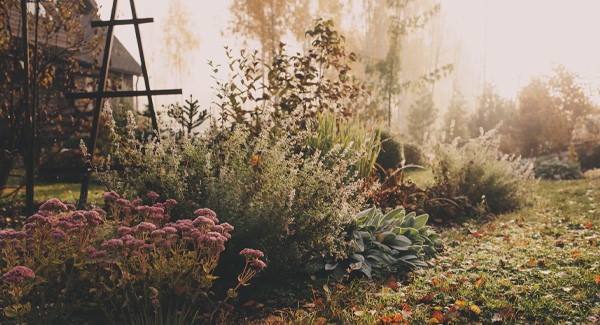
Last Updated on November 22, 2022
Even the most avid gardener enjoys a little down time, and the colder seasons are perfect for cozying up and resting indoors. Here are some important tips for winterizing your garden so that when spring bursts forth, your plants, shrubs, and trees will be in great shape.
Water your plants one to two weeks before the ground freezes
Giving your garden a nice long drink before you disconnect the hose and turn off the water is especially important for new perennials, trees, and shrubs. Watering plants in the fall gives them a better chance of surviving through the colder seasons. If your garden is already well soaked due to rain, you can skip this step.
Once you’re done with the last watering, remove hoses from spigots, make sure they’re empty, and store them in a garage or shed. Empty birdbaths and fountains to ensure they won’t have standing water that can freeze and cause damage. Shut off any irrigation systems before temperatures drop below freezing.
Pull weeds and clear debris
Once you have watered, take advantage of the soil being wet and pull any weeds that are present in your garden. You’ll also want to clean out plant debris and basically anything that doesn’t belong in your garden during growing season. Got any diseased plants? When in doubt, discard them by burning them or putting them in the trash. You don’t want infected plants coming in contact with your garden or compost pile.
Clear leaves from the ground
Fallen leaves can wreak havoc on your lawn if left in a wet layer for the entire winter. Rake them onto a sheet or tarp and relocate them to a part of your property where they can naturally provide cover for pollinators, or to your garden beds where they can act as a mulch layer. Another option is to use a mulching mower to chop the leaves into smaller pieces that will not be detrimental to the grass.
Add a layer of mulch
Mulch does so much to help your garden thrive, even in dormant months. It protects and insulates the roots and the most vulnerable parts of your plants, and it adds organic matter to the soil. Use a loose material that won’t become compacted, such as wood chips, pine straw, or leaves.
Get trees and shrubs ready for winter
This is not the time for pruning, as doing so will promote new growth, which is the opposite of what you want during the colder months. However, it is a good idea to remove dead branches and twigs that are at risk of falling in a storm and causing damage. If you’re trying to establish rose bushes, trees, and shrubs, adding a layer of protection can help, whether it’s a fleece jacket for plants or a DIY garbage bag or cardboard box. Whatever you use, secure it well to avoid losing it to winter breezes.
Move plants indoors as needed
Tender bulbs like dahlias and cannas should be dug up and stored indoors for the winter. Store the bulbs in a dark, cool spot like a basement, and you can replant them in the spring. Some gardeners like to bring annuals like geraniums and begonias indoors for the winter. It’s best to research the ideal indoor conditions for the specific plant you want to keep alive.
Plant spring-blooming bulbs
As long as you get to it before the ground freezes, fall is the time to plant hardy bulbs for the spring, including daffodils and tulips. Choose a spot that gets at least 6 hours of sunlight and has well-drained soil.
Keep reading: 5 easy ways to winterize your home



